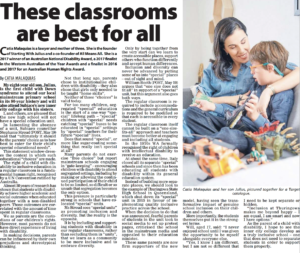In an article that appeared in The Post Newspaper’s 2 June 2018 issue, Starting With Julius founder Catia Malaquias explains why she wants her children to attend an inclusive high school – one that does not need to separate students with disability in order to support them properly.
_______
These Classrooms are Best for All
Catia Malaquias is a lawyer and mother of three. She is the founder of Starting With Julius and a co-founder of All Means All. She is a 2017 winner of an Australian National Disability Award, a 2017 finalist in the Western Australian of the Year Awards and a finalist in 2016 and 2017 for an Australian Human Rights Award.
By CATIA MALAQUIAS
My eight-year old son, Julius, is the first child with Down syndrome to attend our local mainstream primary school in its 80-year history and will also attend Subiaco’s new inner city college with his sisters.
I, and others, are pleased that the new high school will not have a special education unit.
In lamenting the absence of a unit, Subiaco councillor Stephanie Stroud (POST, May 19) said that “ultimately it should be the parents’ choice as to how best to cater for their child’s special educational needs”. This statement window-dresses the context in which such educational “choices” are made.
The right of a child with disability to inclusive education in a regular classroom is a fundamental human right, recognised by a UN Convention ratified by Australia.
Almost 50 years of research has shown that students with disability achieve higher academic and social outcomes when educated together with non-disabled peers. Those outcomes are correlated with the amount of time spent in regular classrooms.
We as parents are the custodians of our children’s rights. However, most parents do not have direct experience of living with disability. In making decisions, parents can be influenced by their own prejudices and stereotypical thinking. Not that long ago, parents chose to institutionalise children with disability – they also chose that girls only needed to be taught “home skills”. Neither of those “choices” is valid today.
For too many children, segregated. “special” education is the start of a one-way “special” lifelong path – “special” children with “special” needs catching “special” buses to be educated in “special” settings by “special” teachers for their future “special” lives. Does that sound “special”, or more like sugar-coating something that really isn’t special at all?
Many parents do not exercise “free choice” but report mainstream schools engaging in “gate-keeping” – encouraging children with disability to attend segregated settings, including by making or allowing the continued participation of their child to be so limited, so difficult or so unsafe that segregation becomes the only option. This pressure is particularly strong in schools that have co-located “special” units.
Ms Stroud sees “special units” as promoting inclusion and diversity. But the reality is the opposite. It is by including and supporting students with disability in our regular classrooms, rather than secluding them in “units”, that we learn as a community to be more inclusive and to embrace diversity. Only by being together from the very start can we learn to create accessible places, support others who function differently and accept human differences. Inclusion and diversity can never be advanced by putting some of us into “special” places – out of sight and mind.
William Booth (POST, May 19) argues that “one size does not fit all” in support of a “special” unit, but this argument also goes both ways. The regular classroom is required to include accommodations and the general curriculum is required to be modified so that each is accessible to every student. The regular classroom itself cannot be built on a “one-size-fits-all” approach and teachers must become better at engaging and including all students.
In the 1970s WA formally recognised the right of children with intellectual disability to receive an education. At about the same time, Italy closed all its separate “special” schools and since then has been educating all students with disability within its general education system.
Instead of building more separate places, we should look to the example of Thuringowa State High School in Queensland, which shut down its “special” unit in 2015 in favour of implementing quality inclusive practice across the school. When the decision to do that was announced, fearful parents of students in the unit took to social media to set up protest pages, criticised the school in the mainstream media and appealed to their education minister. These same parents are now firm supporters of the new model, having seen the transformative impact of genuine school inclusion on their children and others. More importantly, the students themselves put it in the strongest terms.
Will, aged 17, said: “I never enjoyed school until I was given the opportunity to be myself alongside everyone else. “Yes, I know I am different, but I am not so different that I need to be kept separate or hidden. Inclusion at Thuringowa makes me beyond happy – I am equal, I am smart and now I have options.”
As the parent of a child with disability, I hope to see the inner city college develop as a truly inclusive school – one that does not need to separate students in order to support them properly.
[Cover photo © G. Crescoli]
Thank you for visiting our website. You can also keep up with our mission by liking our Facebook page or following
us on Twitter @StartingWJulius

